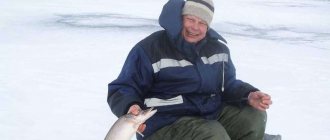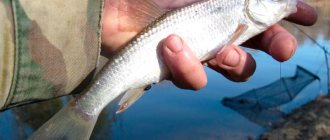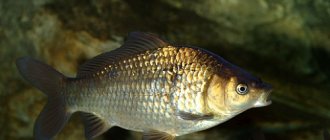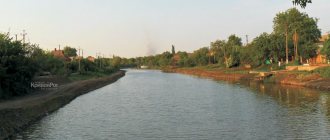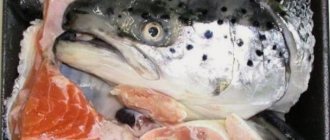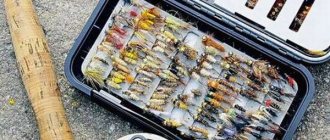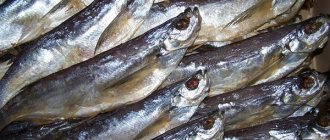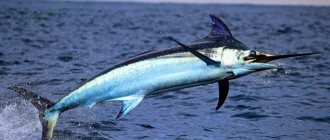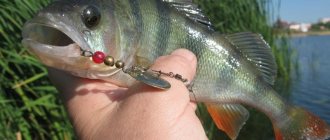Description
Chinese colored carps are the result of long-term selection. For this reason, the requirements for the external data of fish are high, in contrast to natural forms. Breeders who breed Koi professionally are sensitive to their appearance and evaluate the following indicators:
- body proportions
- color
- dimensions
- weight
If the fish deviates from the standards, it is not allowed into breeding.
The head of the fish is blunt-nosed, large, and wide. In the female it is wider due to the so-called cheeks. The male's head is graceful.
The body of a fish, tapering towards the tail. The shoulders are broad and the transition to the tail is subtle and graceful. The tail section is strong, allowing it to maneuver well in the water.
The fins of pets are strong, allowing them to swim easily even in the flow of water. The dorsal fin is low and proportional to the length of the body.
The sizes of pets vary depending on the conditions of detention. When the fish live in a home aquarium (with a volume of at least 400 liters), they grow up to 20 cm. When the fish are kept in an open large reservoir, their length reaches 90 cm, and their weight reaches 6 kg.
The character of koi carp is pleasant and friendly. Unlike other fish, they are intelligent and easy to train. They teach pets to eat from their hands, which especially pleases children.
The color of the fish deserves attention. Its colors are different, but always rich. Fish with an even body color that do not have transitions from tone to tone are valuable. There are species that have intricate patterns of spots on the back, head and sides. Striped fish have also been bred. The basic colors of all carp, both plain and patterned, are as follows:
- gold
- red
- blue
- white
- yellow
- bodily
Raspberry-colored brocade carp are rare. Carp breeders owe the variety of colors to breeders who spent years doing complex and painstaking work before they managed to create individuals with persistent traits.
Handsome and long-lived
Ornamental carp does not live in its natural environment. The Japanese koi lives in artificial reservoirs and aquariums, although other than color it has no other features that distinguish it from its wild counterparts.
There are more than 80 varieties of koi. Most are not considered elite. A total of 14 species of fish have categories that are assigned after several selective selections.
When choosing koi fish, pay attention to the proportionality of the body. The Japanese carp is characterized by a large head and a blunt nose. Adult females have a distinctive feature - their heads are usually wider than those of males due to the “cheeks”.
We recommend reading
Turquoise acara and other varieties
In an elite ornamental carp, the body should gradually decrease from the dorsal fin to the tail. The fins on the ventral part of the body are powerful, the dorsal ones are low and streamlined.
The size of koi carp ranges from 20 cm for aquarium fish to 90 cm for pond koi. Some individuals reach impressive sizes - more than 1 meter. The weight of a young carp is 4 kg, and by adulthood it increases to 10 kg.
The average lifespan of Japanese koi carp is 3 decades. The age of individual individuals reaches 200 years, subject to excellent maintenance.
Classification
Koi are classified by color. Taking into account the numerous subspecies of fish, 60 directions are distinguished. All species and subspecies are reduced to 16 groups, the names of which were in Japanese and remain so. When breeding and keeping carp, Japanese terms are more often used, which have taken root in all countries. The breeds of koi carp are named as follows:
- Kumonryu
- Kohaku
- Doitsu goyim
- Taisho Sanshoku
- Gosicki
- Showa Sanshoku
- Hikari-moyomono
- Bakko
- Ogon
- Utsurimono
- Kinginrin
- Tancho
- Koromo
- Asagi
- Shusui
Having decided to purchase fish and contacting the club, a beginner will get acquainted with the groups and decide which of them will be the best option for him. When you need aquarium carp fish, you need to consider pets such as veiltails and the like. Such aquarium carps live in containers of 150 liters or more.
Description of origin and natural habitat
Koi, translated from Chinese, means ordinary carp, brocade carp. However, there is some confusion in the classification. Thus, until recently, the Amur carp acted as a subspecies; today it is considered to be a separate species.
Unfortunately, there is no exact information about the origin of the fish. It is generally accepted that common carp entered China through traders or naturally. From China, the fish moved to Japanese reservoirs. Carps were first mentioned in written sources in the 14th century.
What size pond is needed?
The volume of a reservoir is important for fish, since only if it is sufficient can they fully grow and reach a size that allows them to reproduce. Ornamental koi carp are large in size, and a standard home aquarium is unsuitable for them.
The volume of an aquarium or pond is calculated according to the following scheme: 5 liters per 1 cm2 of the fish’s body. This shows how large a pond is required for fish. They are not suitable for standard maintenance in an apartment, but in the winter garden they can be used to create a pond that meets the requirements.
If you place fish in a home aquarium, they will be able to live for a long time (although not to old age), but they will never acquire all their beauty and will not delight the owner with their splendor. In essence, these will be runts frozen in the state of a teenager. To understand how much the owner loses by raising carp in a small aquarium, just look at a well-grown ten-year-old specimen. When it is not possible to place fish in a reservoir of the required size, you should refuse to buy them. Although pets live in a small container for some time, such keeping is cruelty towards them.
Equipment
Carps are not picky about their conditions, but despite this, if they do not live in a large open body of water, they will need to acquire some equipment that will help maintain good water quality.
Filter
Without such a device, even with regular cleaning, the water will quickly become cloudy and you will not be able to enjoy watching your pets. You need to purchase a unit with a large filter fraction, as it clogs more slowly. Ideally, 2-3 powerful devices should be installed in a pond. Pets have a high metabolism, and they produce a large amount of waste that must be removed in a timely manner. The filter should be washed when its performance drops. Without filtration, the purity of the contents of the reservoir is impossible.
Sterilization
Some carp breeders see the need for a disinfection device that treats the pond with ultraviolet light. However, without such a device, there is a danger that diseases will arise. Given this, you should not skimp on a sterilizer, which also helps maintain water clarity, which is important for fully enjoying your pets. In order for fish to live longer, a device will also be required.
Aeration
Insufficient oxygen content in water is tolerated by fish quite well and does not pose a danger to them. If there is filtration in the reservoir in which pets are kept, they will be able to survive without aeration. However, to compensate for oxygen deprivation, they will constantly greedily swallow air through their mouths on the surface, which looks extremely unpleasant. A lack of oxygen does not make the appearance of a pond with fish any better, and therefore you should not abandon the compressor.
Backlight
Lighting plays an important role when creating a pond with fish. In dim light, the color of fish from the Cyprinidae family fades, and they lose their beauty. Optimal lighting is bright sunlight. When it is not enough, the carp habitat must be additionally illuminated, for which metal halide lamps are purchased. They provide light as close to natural as possible. There is no need to leave lighting on 24/7. At night, fish, like their owners, sleep, and light only disturbs them. Koi sleep at the bottom, lying on their sides. To maintain the brightness of the color of fish, daylight hours are required for 12-14 hours.
Water requirements
Despite all the unpretentiousness of fish, they need to be provided with water with the required parameters. Water parameters are very easy to determine using chemical tests and a thermometer. For some, the pH of the water should be maintained between 7 and 7.5 (the indicator is equal to the neutral acid-base balance). The fish will not die if there is some shift towards increased acidity, but the pH should not be below 6. It is better to eliminate high acidity promptly, as it leads to a loss of color intensity. Acidity is of primary importance in maintaining a vibrant color.
Only minimal levels of nitrates in water are allowed. For this purpose filtering is provided. Numerous plants also reduce the rate.
Water hardness is an indicator that is kept in the range from 1 to 7. Special compounds will help with this. They are purchased at a pet store.
The water temperature varies significantly. Lonely fish do well at temperatures from 15 to 30 degrees. This allows you to do without a heater. Carps are strong fish, but it is easier for them to tolerate a decrease in water temperature by a couple of degrees than overheating.
Every new breeder needs to have the following cheat sheet.
How to design a fish pond
Proper design of housing for fish is important on the way to obtaining a beautiful reservoir. The soil is selected depending on the color of the pets. They should look advantageous against its background. When the fish are red, the soil is made dark without any additives. For spotted inhabitants, it is better to make the bottom beige.
The soil needed is sand or gravel. It is important that there are no sharp elements in it that could injure pets when they rummage at the bottom.
Pipes and wires in a home pond are hidden under stones so as not to spoil the view. It is not worth setting up grottoes and laying driftwood on the bottom. They are a reservoir for dirt, which causes water conditions to deteriorate and Japanese koi carp do not like to hide.
Plants chosen are strong and can withstand being bitten by fish. There should not be many of them, as fish need sufficient space to swim. Without it, they develop diseases of the muscular system.
Interesting features and difficulties of reproduction
Japanese carp is a fish that not only has a unique color, but also the ability to train. Japanese koi kept in home ponds or aquariums quickly get used to their owners, recognizing them by their voice and even their steps. They do not resist when they are petted.
We recommend reading
Colored aquarium fish Ternetia
Koi breeding is not possible in an aquarium. Although, if the container contains 1500-2000 liters of water, then spawning is possible. The fish reach sexual maturity when their body length reaches 25 cm. They spawn in the pond in the spring - they spawn. The optimal water temperature for reproduction is 20 degrees.
Feeding
Proper nutrition for fish is very important. With a well-formulated diet, the risk that the pet will contract diseases and die before old age is reduced. Koi food and feeding regimen are shown in the table.
You need to buy pellets from a manufacturer who can guarantee the quality and safety of the product. With a properly selected diet, the lifespan of carp is about 35 years. If the most comfortable conditions are created for the fish, then it is possible that it will exceed the age of 70 years.
Feed should be given in this way:
- portion should be eaten within 10 minutes
- feed should not dissolve in water, leading to its contamination
- feeding is carried out in the morning, afternoon and evening
- feed portion is calculated based on the number of fish
- The norm of food for a pet is 3% of its weight
You cannot give food in large portions once a day, as the pets will not digest it, and most of the food will end up at the bottom and cause the water to rot. When it is not possible to feed yourself, use an automatic feeder.
Maintenance in the Russian climate
To breed Japanese carp in Russian conditions, choose adapted individuals raised in more severe climatic conditions than carp from China or Japan. The depth of the pond should be at least 2 m, while at the bottom it is necessary to dig a 0.5 m hole. This is necessary so that during hot periods the fish can hide in the cool, and in winter, on the contrary, in warmer water.
When the ambient temperature drops to +10 degrees, lasting at least 14 days, koi carp, which is kept in a pond, begin to be fed once a day. This is done so that the food does not rot in the fish’s stomach, because during this period all processes in the carp’s body slow down.
In cold weather, the pond is covered with polyethylene. Be careful not to form ice, otherwise the fish will suffocate.
We recommend reading
Description of piranha fish species: what it looks like and where it lives
Diseases usually avoid koi carp. Sometimes owners encounter worms, fungal infections, ichthyophthyriasis, costiosis, and flukes.
Diseases
Their immunity is high, and they rarely get sick. More often, diseases appear due to poor maintenance. The owner may encounter the following problems with his pets:
- costiosis
- ichthyophthyriosis
- fungal infections (secondary)
- helminthic lesions
- fluke lesions
In order to prevent diseases, it is necessary to keep the pond clean, and introduce new inhabitants only after they have been in quarantine for 10 days.
Compatibility
It is not necessary to keep carp exclusively in a species-specific reservoir. Due to their peaceful nature, koi carps in the pond get along well with other fish. Their neighbors may be:
- goldfish
- catfish (large)
- platies
- trout
- minnows
Small fish, as well as gouramis and angelfish, are not suitable for proximity. Having reached a certain size, carp will easily swallow them, even if they have lived with them since childhood.
Keeping koi carp in a pond with other calm, large fish is not difficult.
Advantages and disadvantages
Before you get carp, whose homeland is Japan, you evaluate their pros and cons relative to specific conditions. The advantages of pond inhabitants are:
- omnivorous
- longevity – carp live for more than 50 years under good conditions
- attractive appearance
- undemanding
- Training – Japanese koi carp remembers up to 20 commands
- strong immunity – diseases are rare
- tolerance to low water temperature
In addition to advantages, fish also have disadvantages, but they only appear when koi carp are kept in an aquarium with a volume of less than 500 liters. The disadvantages include:
- Small size of fish - in an aquarium they grow to a maximum of 15 cm
- impossibility of breeding koi carp - spawning of koi carp is possible only if its size is at least 30 cm.
- faded color due to the tightness of the fish
- the need for a daily change of 30% water
For pond keeping there are no disadvantages.
According to breeders, the most decorative species are those with veil fins and mirror scales. Their cost is higher than that of ordinary fish, but this is quite justified. When buying carp for an aquarium, you need to inspect them. If damage or defects are detected on the body, the offered product is rejected.
This conditionally aquarium fish from the Karpov family conquers breeders over and over again. Although the aquarium hobby is fascinating, brocade carps remain primarily ornamental pond fish.
AdminAuthor of the article
Did you like the article?
Share with your friends:
Content
There are cases of keeping koi not only in home-made ponds, but also in illuminated city fountains. It is allowed to keep koi carp in an aquarium with high-quality and constant maintenance. You can't do without expensive equipment. Japanese carp are demanding when it comes to water purity. Water parameters:
- temperature 15–30 degrees;
- pH 7–7.5, during treatment of fish it is allowed to increase the value to 8;
- hardness 1–7.
Avoid sudden changes in water parameters. If not maintained correctly, wounds and small ulcers form on the body. Poor water quality leads to gill rot and other infectious diseases with fatal consequences. Signs of the onset of the disease are decreased appetite and lethargy. Koi are susceptible to ichthyophthyriasis, during which ciliates parasitize the skin. In infected fish, a swelling appears at the site where the parasite penetrates the skin. It is treated with a solution of table salt or malachite green.
Reservoir dimensions
Koi are active fish and require a lot of space for normal development. For every centimeter of a fish's body there is at least 5 liters of water. Keep in mind that fish grow as they live. Koi are kept in an aquarium of 500 liters or more.
Scenery
When decorating an aquarium, focus on the colorful inhabitants. Pisces look great against a plain background. Fish love to dig and move decorations. Think about the color combination in advance: bright fish look impressive against a dark background.
Limit yourself to a minimum of plants and accessories - excess design distracts from contemplating the koi and takes up space in the aquarium. Choose sandy or fine gravel soil.
Equipment
Equipment you will need:
- Filter. A large aquarium requires a powerful filter. Choose external devices. They are more powerful and provide high-quality filtration. You may need several devices for proper filtration.
- Compressor. Koi carps require oxygenation of the water. For filtration and aeration, purchase two different devices. You should not entrust aeration to a filter.
- Lamp. For the brightness of the color of koi, intense lighting and adherence to the light regime of the day are required.
Vegetation
Refrain from planting plants in the ground - carps will dig up the greens. Place several hanging pots in the aquarium at a distance of 15 cm from the bottom. Place plastic plants.
